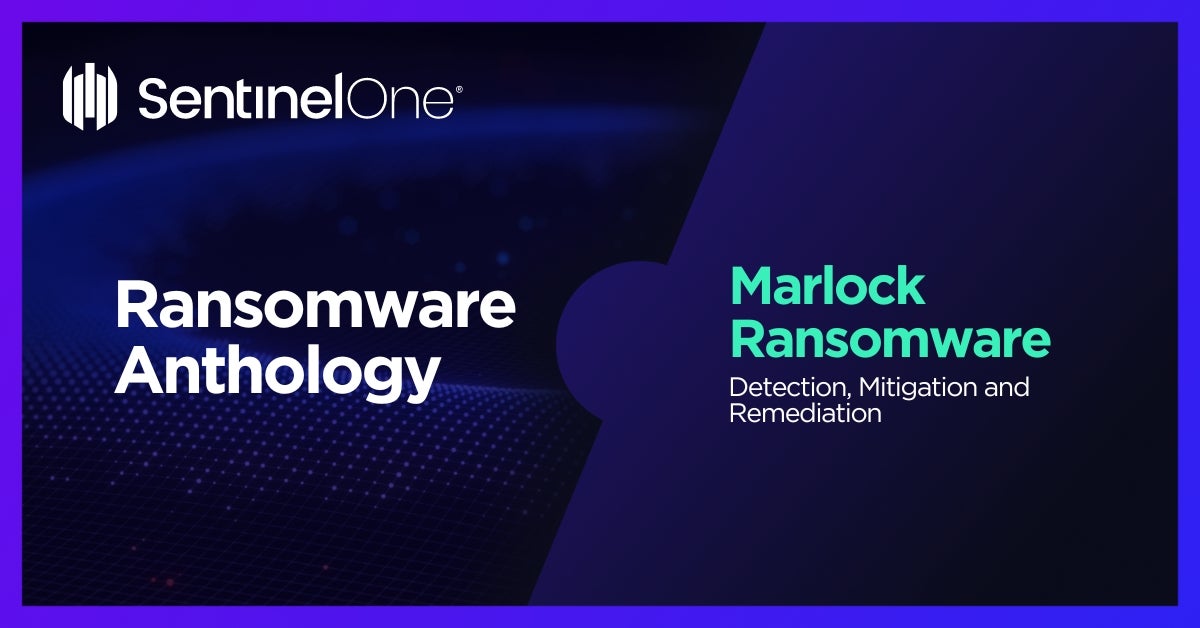Marlock Ransomware: In-Depth Analysis, Detection, and Mitigation
Summary of Marlock Ransomware
Marlock ransomware was first seen in the wild in September of 2021 and is an evolution of MedusaLocker and the various branches of that family. Early samples of Marlock are functionally identical to recent samples of both Medusa and Huylock. Marlock practices double extortion – demanding payment for a decryptor, as well as for the non-release of stolen data.

What Does Marlock Ransomware Target?
Marlock ransomware has been known to target a variety of industries, including healthcare, finance, manufacturing, and government agencies.
How Does Marlock Ransomware Spread?
Initial access and delivery can vary across campaigns. Marlock ransomware actors are known to exploit vulnerabilities in ScreenConnect and RDP to achieve their initial foothold.
Marlock Ransomware Technical Details
In September 2021, the Marlock ransomware emerged as an evolution of the MedusaLocker and its branches. It functions identically to recent samples of Medusa and Huylock. It is also able to self-spread to mapped drives and delete Volume Shadow Copies (through WMIC) to prevent system recovery. Additionally, it shuts down any processes that may interfere with the encryption process.
When infected, victims are instructed to connect to the attacker’s paymore portal (.onion) through TOR and contact additional email addresses for “support”.
How to Detect Marlock Ransomware
- The SentinelOne Singularity XDR Platform can identify and stop any malicious activities and items related to Marlock.
In case you do not have SentinelOne deployed, detecting ransomware requires a combination of technical and operational measures designed to identify and flag suspicious activity on the network. This allows the organization to take appropriate action, and to prevent or mitigate the impact of the ransomware attack.
To mitigate the risk of this Ransomware without SentinelOne deployed, it is important to take a multi-layered approach, which includes the following steps:
- Use anti-malware software or other security tools capable of detecting and blocking known ransomware variants. These tools may use signatures, heuristics, or machine learning algorithms, to identify and block suspicious files or activities.
- Monitor network traffic and look for indicators of compromise, such as unusual network traffic patterns or communication with known command-and-control servers.
- Conduct regular security audits and assessments to identify network and system vulnerabilities and ensure that all security controls are in place and functioning properly.
- Educate and train employees on cybersecurity best practices, including identifying and reporting suspicious emails or other threats.
- Implement a robust backup and recovery plan to ensure that the organization has a copy of its data and can restore it in case of an attack.
How to Mitigate Marlock Ransomware
- The SentinelOne Singularity XDR Platform can return systems to their original state using either the Repair or Rollback feature.
In case you do not have SentinelOne deployed, there are several steps that organizations can take to mitigate the risk of ransomware attacks:
- Educate employees: Employees should be educated on the risks of ransomware, and on how to identify and avoid phishing emails, malicious attachments, and other threats. They should be encouraged to report suspicious emails or attachments, and to avoid opening them, or clicking on links or buttons in them.
- Implement strong passwords: Organizations should implement strong, unique passwords for all user accounts, and should regularly update and rotate these passwords. Passwords should be at least 8 characters long, and should include a combination of uppercase and lowercase letters, numbers, and special characters.
- Enable multi-factor authentication: Organizations should enable multi-factor authentication (MFA) for all user accounts, to provide an additional layer of security. This can be done through the use of mobile apps, such as Google Authenticator or Microsoft Authenticator, or through the use of physical tokens or smart cards.
- Update and patch systems: Organizations should regularly update and patch their systems, to fix any known vulnerabilities, and to prevent attackers from exploiting them. This includes updating the operating system, applications, and firmware on all devices, as well as disabling any unnecessary or unused services or protocols.
Implement backup and disaster recovery: Organizations should implement regular backup and disaster recovery (BDR) processes, to ensure that they can recover from ransomware attacks, or other disasters. This includes creating regular backups of all data and systems, and storing these backups in a secure, offsite location. The backups should be tested regularly, to ensure that they are working, and that they can be restored quickly and easily.